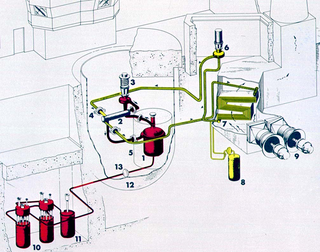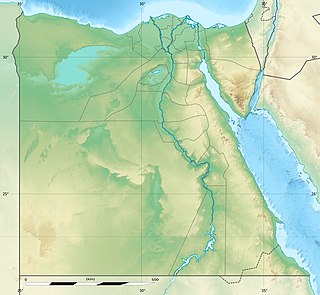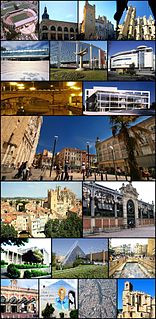Enriched uranium is a type of uranium in which the percent composition of uranium-235 has been increased through the process of isotope separation. Natural uranium is 99.284% 238U isotope, with 235U only constituting about 0.711% of its mass. 235U is the only nuclide existing in nature that is fissile with thermal neutrons.
A gas nuclear reactor is a proposed kind of nuclear reactor in which the nuclear fuel would be in a gaseous state rather than liquid or solid. In this type of reactor, the only temperature-limiting materials would be the reactor walls. Conventional reactors have stricter limitations because the core would melt if the fuel temperature were to rise too high. It may also be possible to confine gaseous fission fuel magnetically, electrostatically or electrodynamically so that it would not touch the reactor walls. A potential benefit of the gaseous reactor core concept is that instead of relying on the traditional Rankine or Brayton conversion cycles, it may be possible to extract electricity magnetohydrodynamically, or with simple direct electrostatic conversion of the charged particles.

The nuclear fuel cycle, also called nuclear fuel chain, is the progression of nuclear fuel through a series of differing stages. It consists of steps in the front end, which are the preparation of the fuel, steps in the service period in which the fuel is used during reactor operation, and steps in the back end, which are necessary to safely manage, contain, and either reprocess or dispose of spent nuclear fuel. If spent fuel is not reprocessed, the fuel cycle is referred to as an open fuel cycle ; if the spent fuel is reprocessed, it is referred to as a closed fuel cycle.

Uranium hexafluoride (UF6), colloquially known as "hex" in the nuclear industry, is a compound used in the process of enriching uranium, which produces fuel for nuclear reactors and nuclear weapons. Hex forms solid grey crystals at standard temperature and pressure, is highly toxic, reacts with water, and is corrosive to most metals. The compound reacts mildly with aluminium, forming a thin surface layer of AlF3 that resists any further reaction from the compound.

Gaseous diffusion is a technology used to produce enriched uranium by forcing gaseous uranium hexafluoride (UF6) through semipermeable membranes. This produces a slight separation between the molecules containing uranium-235 (235U) and uranium-238 (238U). By use of a large cascade of many stages, high separations can be achieved. It was the first process to be developed that was capable of producing enriched uranium in industrially useful quantities.

K-25 was the codename given by the Manhattan Project to the program to produce enriched uranium for atomic bombs using the gaseous diffusion method. Originally the codename for the product, over time it came to refer to the project, the production facility located at the Clinton Engineer Works in Oak Ridge, Tennessee, the main gaseous diffusion building, and ultimately the site. When it was built in 1944, the four-story K-25 gaseous diffusion plant was the world's largest building, comprising over 1,640,000 square feet (152,000 m2) of floor space and a volume of 97,500,000 cubic feet (2,760,000 m3).

Eurodif, which means European Gaseous Diffusion Uranium Enrichment Consortium, is a subsidiary of the French company Orano, which operates a uranium enrichment plant established at the Tricastin Nuclear Power Center in Pierrelatte in Drôme. The nuclear site of Pierrelatte includes many nuclear installations, of which the largest are the Eurodif fuel factory and the Tricastin nuclear power station.
Molecular laser isotope separation (MLIS) is a method of isotope separation, where specially tuned lasers are used to separate isotopes of uranium using selective ionization of hyperfine transitions of uranium hexafluoride molecules. It is similar to AVLIS. Its main advantage over AVLIS is low energy consumption and use of uranium hexafluoride instead of vaporized uranium.

The S-50 Project was the Manhattan Project's effort to produce enriched uranium by liquid thermal diffusion during World War II. It was one of three technologies for uranium enrichment pursued by the Manhattan Project.
Separation of isotopes by laser excitation (SILEX) is a process for isotope separation that is used to produce enriched uranium using lasers. It was developed in the 1990s, based on earlier technologies.

The Molten-Salt Reactor Experiment (MSRE) was an experimental molten salt reactor at the Oak Ridge National Laboratory (ORNL) researching this technology through the 1960s; constructed by 1964, it went critical in 1965 and was operated until 1969.
The National Enrichment Facility (NEF) is a plant for the enrichment of uranium. The plant uses a gas centrifuge technology known as Zippe-type centrifuges. It is located 5 miles east of Eunice, New Mexico. The NEF is operated by Louisiana Energy Services (LES), which is in turn owned by the Urenco Group. As of 2011, LES operates as URENCO USA.

The Fernald Feed Materials Production Center is a Superfund site located within Crosby Township in Hamilton County, Ohio, as well as Ross Township in Butler County, Ohio. It was a uranium processing facility located near the rural town of New Baltimore, about 20 miles (32 km) northwest of Cincinnati, which fabricated uranium fuel cores for the U.S. nuclear weapons production complex from 1951 to 1989. During that time, the plant produced 170,000 metric tons uranium (MTU) of metal products and 35,000 MTU of intermediate compounds, such as uranium trioxide and uranium tetrafluoride.
Sequoyah Fuels Corporation owned and operated a uranium processing plant near Gore, Oklahoma. The company was created in 1983 as a subsidiary of Kerr-McGee. In 1988 it was sold to General Atomics.
ConverDyn is a general partnership between American multinational firms General Atomics and Honeywell that provides uranium hexafluoride (UF6) conversion and related services to utilities operating nuclear power plants in North America, Europe, and Asia. The company is the sole marketing agent of UF6 produced at the Honeywell Uranium Hexafluoride Processing Facility in Metropolis, Illinois.

The Fuel Manufacturing Pilot Plant (FMPP), also known as Fuel Element Fabrication Plant, is a nuclear fuel fabrication facility supplied by the Argentine company INVAP in 1998. The FMPP is considered a Material Testing Reactor (MTR)-type fuel element facility, that produces the fuel elements required for the research reactor ETRR-2.



















